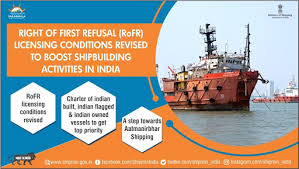
India boosts Domestic Shipping Industry with Strategic Initiatives
NEW DELHI : In a significant move to bolster India’s maritime sector, the government has implemented a series of measures aimed at enhancing the capacity and competitiveness of Indian shipping lines.
These initiatives are designed to reduce dependency on foreign shipping companies and address the pressing issue of rising freight costs.
The cornerstone of this strategy is the revised Right of First Refusal (ROFR) policy. This policy now prioritises Indian-built and Indian-flagged vessels in a hierarchical manner, giving them the opportunity to match the lowest bid offered by foreign-flagged vessels.
The new ROFR hierarchy strongly favours vessels that are Indian-built, Indian-flagged, and Indian-owned, followed by those owned by Indian International Financial Services Centre Authority (IFSCA) entities.
Complementing the ROFR policy is a substantial subsidy support scheme launched in 2021. With a budget of Rs 1,624 crore allocated over five years, this initiative aims to promote the flagging of merchant ships in India.
The scheme provides financial assistance to Indian shipping companies participating in global tenders for importing essential government cargo such as crude oil, LPG, coal, and fertilizers.
Further strengthening the sector is the Ship Building Financial Assistance Policy (2016-2026). This policy offers financial support to Indian shipyards, granting assistance of up to 20 per cent of the contract price for eligible vessels.
The policy is designed to incentivise domestic shipbuilding and improve the competitiveness of Indian shipyards in the global market.
These concerted efforts have yielded positive results. As of June 2024, India boasts a fleet of 485 Indian-flagged vessels with 11.95 Million Gross Tonnage (GT) operating in overseas trade. An additional 1,041 vessels with 1.7 Million GT are engaged in coastal trade.
The total Indian-flagged fleet now stands at 1,530 vessels with a combined 13.7 Million GT, marking a consistent increase in Indian tonnage over the past decade.
The impact of these initiatives extends beyond mere numbers. There has been a notable shift in business preference towards Indian-flagged vessels, indicating growing confidence in the domestic shipping industry. This trend not only supports India’s vision of becoming self-reliant or ‘Atmanirbhar’ in the maritime sector but also contributes significantly to the country’s economic growth.
As India continues to strengthen its position in global maritime trade, these strategic initiatives are expected to play a crucial role in shaping the future of the nation’s shipping industry.
The government’s commitment to developing a robust domestic shipping sector underscores India’s determination to become a major player in international maritime commerce.
